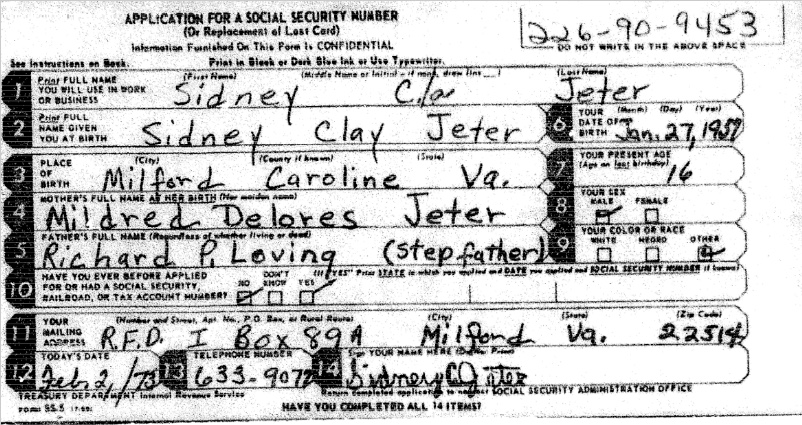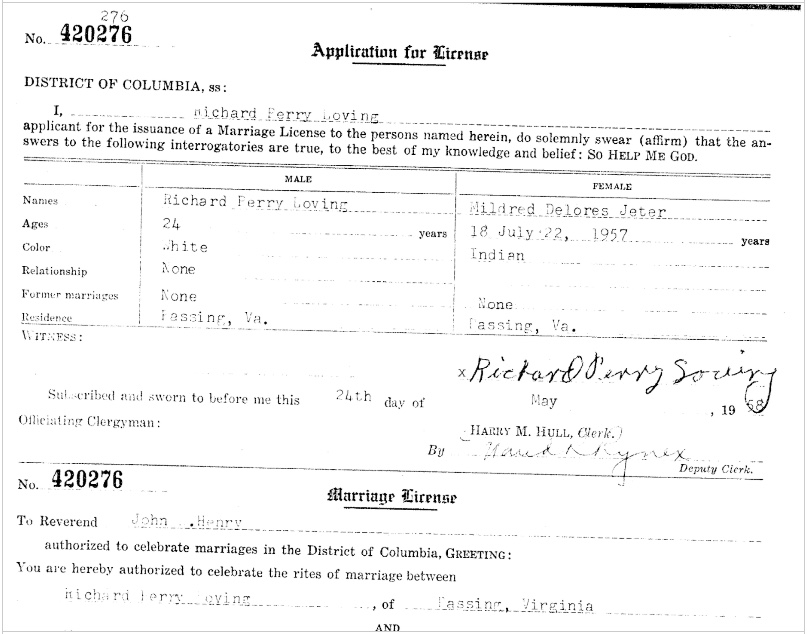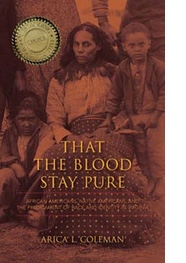What’s Fact and Fiction in Jeff Nichols’s Film about the Lovings
Award winning writer/director Jeff Nichols’s highly anticipated filmLoving, which was released nationwide on November 4, 2016, recounts the intriguing story of Richard and Mildred Loving, the plaintiffs in the 1967 Supreme Court case Loving v. Virginia,which overturned proscriptions against interracial marriage in the United States. In 1958, Richard Loving a “white” man and Mildred Jeter a “colored” woman, violated several Virginia codes when they married in the District of Columbia, where interracial marriage was legal, and afterwards returned to their home in Caroline Country, Virginia, where interracial marriage was illegal, to live as husband and wife. The couple was taken to jail, tried for the crime of being married and then banished from Virginia for 25 years.
As highlighted in my recent article “The Black and White Worlds of Loving v. Virginia” the film is approximately 2 hours and focuses on the nine year period of the couple’s hardship during courtship, marriage and banishment; and their ultimate Supreme Court triumph. The story line follows the popular narrative of the Loving story, but in typical Hollywood fare, it also takes some creative liberties. Below are some highlights of the facts and fictions of the movie.

Mildred’s pregnancy was the impetus for the couple’s choice to marry: Fact, but . . .
The film opens with Mildred breaking the news of her pregnancy to Richard; this scene and a subsequent one continues the popular myth that Mildred was pregnant with the couple’s first child Sidney; but in fact Sidney C. Jeter, who kept his mother’s maiden name throughout his lifetime, and identified Richard as “stepfather” on his Social Security application, was Mildred’s son from a prior relationship; he was born on January 27, 1957, almost a year and a half before the Loving’s married on June 2, 1958. Mildred was pregnant with Donald, the couple’s first child who was born on October 8, 1958, four months after they married.

The Lovings married in Washington, D.C. because interracial marriage was illegal in Virginia: Fact, but . . .
Due to Virginia’s 1924 Racial Integrity Act, which forbade interracial marriage, Richard and Mildred married in D.C. As the movie indicates, Richard proudly framed and displayed the couple’s marriage license on the back bedroom wall of Mildred’s parent’s house where the newlyweds slept; but, the Lovings also married in D.C. because Virginia law forbade anyone from racially identifying as Indian on any government documents, except for those residing on the reservations in King William County. As I demonstrate in “What You Didn’t Know About Loving v. Virginia, the couple’s Central Point community overwhelmingly identified as white or Indian. A close up of a replica of the marriage license in the film only shows the middle section which contains the couple’s names and residence ironically dubbed “Passing Virginia.” The actual marriage license has three parts. The top part of the document shows the couple’s names and racial identity which reads: Richard Perry Loving, white; Mildred Delores Jeter, Indian.
The Lovings were arrested twice: Fact and Fiction
The Loving’s were arrested twice. The first incident occurred on July 11, 1958. At approximately 2 a.m., Sheriff R. Garnett Brooks and two of his deputies barged into the Lovings’ bedroom (in those days residents of rural communities did not lock their doors) and arrested them for the crime of miscegenation. On January 6, 1959, the Lovings entered a guilty plea before Judge Leon Bazile. The judge suspended the couple’s one year prison sentence on condition that they immediately leave Virginia and not return to the state for 25 years. They were allowed to return separately to visit their respective families.
 Nichols’s
account of the second arrest is fictional. He presents a heart
wrenching scene in which the couple is discovered at the home of Lola
Loving, Richard’s mother, the local midwife. Sheriff Brooks and a
deputy arrive not long after Mildred has given birth to Sidney and
arrest the couple for violating the condition of their parole. The
Lovings’ lawyer, Frank Beazley, lies to Judge Bazile telling him
that he had misinformed his clients that they were allowed to return
to the county together for the baby’s birth. This intervention
prevents the couple from returning to jail, but the attorney warns
them that he will not intervene again.
Nichols’s
account of the second arrest is fictional. He presents a heart
wrenching scene in which the couple is discovered at the home of Lola
Loving, Richard’s mother, the local midwife. Sheriff Brooks and a
deputy arrive not long after Mildred has given birth to Sidney and
arrest the couple for violating the condition of their parole. The
Lovings’ lawyer, Frank Beazley, lies to Judge Bazile telling him
that he had misinformed his clients that they were allowed to return
to the county together for the baby’s birth. This intervention
prevents the couple from returning to jail, but the attorney warns
them that he will not intervene again.
In fact, the second arrest occurred during the Easter holiday in March 1959 when Donald, who was delivered by his midwife grandmother, was 5 months old; also, Beazley had indeed misinformed the couple by telling them that they were allowed to return to Virginia together for family visits as long as they did not sleep in the same house. Beazley’s error prevented the Lovings from returning to jail.
Mildred Loving wrote to Attorney General Robert Kennedy: Fiction
A scene in the movie shows Mildred writing to then U. S. Attorney General Robert Kennedy. She later receives a call from lawyer Bernard Cohen of the American Civil Liberties Union stating that her letter to Kennedy had been forwarded to him.
This assumption follows family lore that Mildred wrote to Kennedy about the family’s dilemma and in his written response to her, he recommended that she write to the ACLU. There is no evidence of any correspondence between Mildred Loving and Robert Kennedy. Cohen responded directly to a letter the ACLU received from Mildred dated June 20, 1963. Kennedy was not mentioned.
Two lawyers handled the Loving case: Fact
This was a welcome corrective to the 1996 movie Mr. and Mrs. Lovingwhich portrayed Bernard Cohen as the sole lawyer who represented the case; but, in fact Philip Hirschkop, who was more experienced in the area of civil rights, signed on to the case as co-counsel in 1964. While both lawyers were quite young, Nichols’s representation of Cohen as a bumbling, naïve attorney dependent on the superior legal wisdom of his colleague provides a source of comic relief, perhaps poetic justice for the earlier oversight.
Richard Loving told his lawyer “Tell the judge I love my wife”: Fiction
The Lovings chose not to accompany their lawyers to the Supreme Court during oral arguments, but Richard gave his lawyers a message for the justices stating, “Tell the court I love my life, and it is just unfair that I cannot live with her in Virginia.” The Court unanimously agreed.